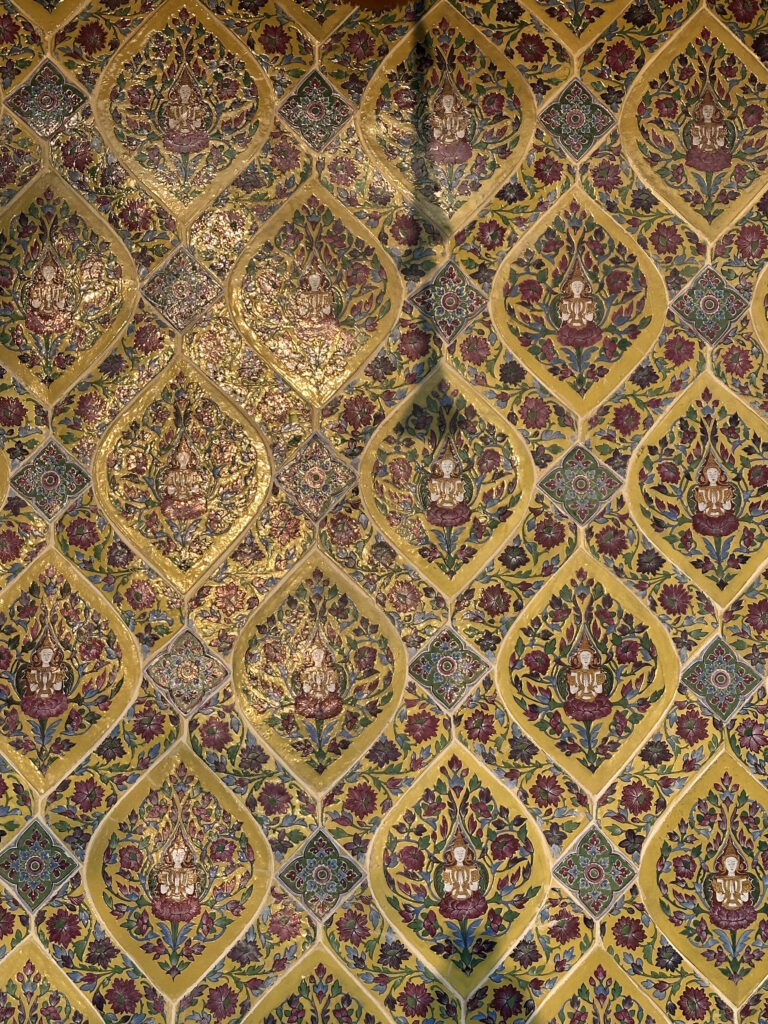A reminder of human’ stewardship of the earth
For three days in April, the streets of Thailand transform into a vibrant canvas of joy and togetherness. Songkran is a celebration of the Thai New Year, a time for renewal, family, and faith. The festival’s origins can be traced back centuries, evolving from Animism amd ancient Hindu rituals to the modern-day celebration we know today.
The heart of Songkran lies in the playful tradition of water splashing, symbolizing the washing away of the past and welcoming the new year with a clean slate.


Water holds immense symbolic and practical significance in Thai culture. The symbolic use of water is deeply intertwined with religious beliefs, traditions, and daily life. Water represents the cyclical nature of life, mirroring the monsoon seasons and the renewal of the land.
As guardians of water sources, the naga serpents represent abundance and protection. The nagas connect the elements of earth, water, and sky, inducing rainfalls from the sky onto the parched earth. The multicoloured scales of the nagas reflect the sunlight, creating a rainbow bridge that extends from the earth into the sky and connects the earthly to the spiritual realms.

Flowers and plants play a vital role in religious practices, social interactions, and everyday life in Thailand. They are more than just decorative items; they are powerful symbols that convey deep spiritual, cultural, and emotional meanings.
Rising from muddy waters to bloom flawlessly, lotus flower (nelumbo nucifera) represents purity of mind and spirit, as well as enlightenment.The lotus flower is considered sacred in Buddhism, symbolizing purity, enlightenment, and spiritual awakening.
Champaka flower (magnolia champaca) is an auspicious flower that brings about advancement in various aspects, especially career growth and access to elders. The champaka flower also has a fragrant smell, making it a popular flower for worshipping Buddha and deities according to Thai beliefs.
White Arabian jasmine (jasminum sambac) symbolizes purity, respect, and maternal love. It’s often used in garlands (phuang malai) offered to elders and revered figures.
Frangipani (plumeria) can symbolize new beginnings, and also can be associated with the shedding of sorrows.
Sandalwood (santalum album) is known for its fragrant wood and believed to have purifying and protective qualities.It is used to create incense, fragrant oils, and ceremonial objects.
Fragrance holds a deeply ingrained and multifaceted significance in Thai culture, permeating both ritualistic and everyday life. Various kind of flora and vegetation are used to create fragrant substances, especially scented water or Nam Ob Thai (น้ำอบไทย).
The creation of Nam Ob Thai involves intricate processes with specific flowers, and techniques passed down through generations. It is used in religious ceremonies to purify spaces, objects, and individuals that is a hallmark of cultural practices during Songkran.

Chedi Sai (เจดีย์ทราย) or a sand stupa is a replica of a stupa containing the hair relics of the Buddha on the top of the mythical mount Meru. During Songkran, people often carry sand that has been carried away from the temple grounds on their shoes. Building sand pagodas is seen as a way to return this sand and symbolically atone for unintentionally taking something away from the sacred space.
Building sand pagodas is seen as a way to return this sand and symbolically atone for unintentionally taking something away from the sacred space.
It is a way to ask for forgiveness for any wrongdoings committed during the past year. The sand pagoda is therefore a symbol of atonement and forgiveness.
As a representation of the sacred stupa on the peak of mount Meru, a sand pagoda also symbolizes the center of universe and the highest ideal for every Buddhist.


Decorating many stupas and other religious artefacts is the motif of Thep Phanom, which depicts a “devata” (a celestial being or deity) performing the “anjali mudra” hand gesture, commonly known as the “phanom mue” in Thailand. This gesture signifies respect, reverence, and offering.
Phanom also means a mountain. Hence, the Thep Phanom pattern also symbolizes the state of mindfulness and of being centred and grounded within oneself like mount Meru.
Hence, a sand pagoda and the Thep Phanom patterns also symbolizes the state of mindfulness and of being centred and grounded within oneself.
The Thai New Year is a vibrant celebration centered around water splashing. This symbolizes cleansing away the past, purifying the body and mind, and welcoming a fresh start. Intricately designed water bowls or Khan Nam (ขันน้ำ) are used in religious ceremonies and rituals during Songkran
The motifs that often appear on Thai water bowls include the nagas, floral and vegetal patterns, as well as the Thep Phanom motif, symbolizing purification and blessings, as well as the interconnectedness of the earth, the sky and the spiritual realms.


Wau (ว่าว) is a Thai word for “kite”. Each year from February to April, when the southerly wind blows, it is the time for kite flying. Although it is not directly connected to Songkran, kite flying is a popular activity during the month of Mesha Sankranti.
Kite flying is not just a game. In Thailand, the Royal Kite Festival was historically associated with the start of the agricultural season, seeking good winds and rainfall for crops.
Kites are sometimes seen as connectors between heaven and earth, sending prayers and wishes skyward.
In Cambodia and Laos, kites (such as the Kleng Ek) were historically flown at night with a humming bow, believed to communicate with celestial beings and bring harmony between humans and nature.
Through these symbolism, Songkran encourages participants to appreciate and care for nature, and to accept change and impermanence. Beyond the veneer of the joyful water festival, It also invites participant to reflect on the consequences of their actions and the importance of responsible stewardship of the earth.
